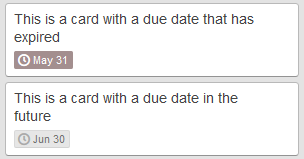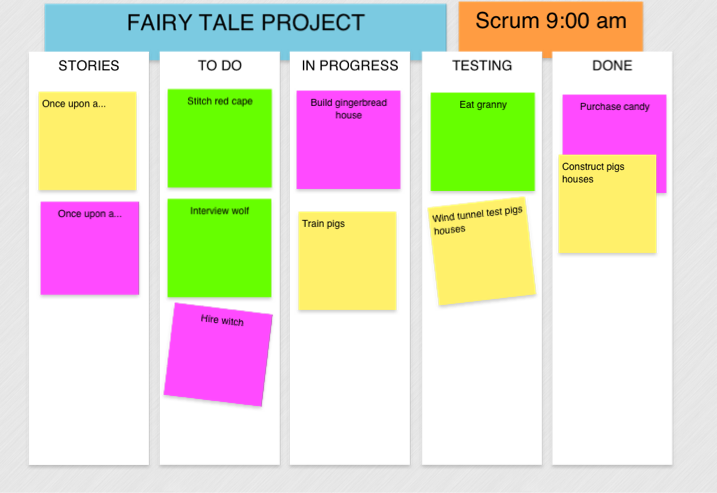Managing any kind of software project requires planning out tasks, assigning them to people, tracking the status of each task and so on. Many teams use a whiteboard with sticky Post-it notes arranged in columns, with column names such as “Stories”, “To Do”, “In Progress”, “Testing” and “Done”. If you are Agile of mind you might call this a Scrum Task Board for the not so agile it might be a Project Planning Board. Regardless of your agility and what label you give it, it kind of looks like the one below.
Whiteboards are simple technology, mostly hard to break and great at communicating project information to the team as long as the entire team has physical access to the whiteboard.
Nowadays teams tend to be geographically dispersed and virtual and can benefit from my favorite online whiteboard Trello.
My wallet and I like things which are simple and cheap. Trello is almost as simple as the whiteboard and according to their site “Trello is free, now and forever”. Hmmm…sounds too good to be true. Well it is at least free for now so let’s get planning.
Every user that interacts with Trello must have a Trello account. Signing up is easy, you can use your Google account or if you are a rebel and don’t have a Google account you can use your email address and a password to sign up. Remember to write the password on a Post-it so you don’t forget it 😉
Take a tour of all the Trello features at https://trello.com/tour or if reading is not your thing watch the movie.
Here is some Trello terminology to keep you on the right track:
- Organization ≈ an organization (don’t worry it gets more complicated below)
- Board ≈ whiteboard
- List ≈ whiteboard column
- Card ≈ Post-it note
Here are some of the things I like about Trello in no particular order:
- It is browser based and Chrome keeps track of my password so I don’t need one of them Post-it thingies stuck to my monitor.
- The interface is about as clean and simple as…well…a whiteboard.
- You can drag and drop cards without getting them stuck to your fingertips.
- Cards change size so you don’t have to use multiple chained Post-its to get your point across.
- You can attach files, videos, pictures, hyperlinks and comments to a card. Try that with a Post-it.
- Cards can have due dates and get highlighted (subtly) if the due date has passed you by.

- You can assign cards to multiple members.
- You get an email when a card is assigned to you.
- You can subscribe to a card, so if somebody changes it or moves it to another list you get notified by email. Great for keeping on top of things.
- Cards can have a checklist of sub-tasks associated with that card and you can see at a glance how many of the sub-tasks have been completed.

- You can set up multiple organizations in one account. Nice feature if you work with multiple organizations like I do and/or get invited to Trello boards from other organizations.
- You can create as many boards with as many lists and cards as you want.
- You can invite other users to be members of an organization or board.
- Cards can be color coded (kind of) and categorized.
- Lots of keyboard shortcuts as you would expect of any good application.
- Activity feed for each card and board shows who changed what.
- You can filter the board by category or user to show only those cards for the selected category or user.
- Works almost identically in the browser, on the iPad, iPhone, Android and Windows 8 (truthfully I have only tested it on the Apple devices, so I am guessing about the others).
- The learning curve is most definitely lacking in curves. It is so simple to use that if one of your team members doesn’t get it, then you need to get a replacement team member 😉
Wow that was a lot of things to like about Trello. To bring some balance to the universe here is what I don’t like about it:
- You can’t filter cards in the mobile apps.
- You can’t have different colored cards. You can categorize cards which gives them a different colored teeny tiny bar at the top of the card, but I want my boards to be colorful like real life whiteboards with all the neon colored Post-its.
- Every member assigned to a board has the same rights. That is they can change anything on the board and obliterate it or parts of it if they so desire. Now this is a good thing from an Agile mindset because everybody should be equal and have an equal say blah blah blah, but people are well human and make mistakes. The good news is that you can see who to blame 😉 from the board activity feed, because every mistake is recorded for all to enjoy. If you scrounge together the $25/month to upgrade to Business Class you get a bit more control over this, but members with edit rights can still cause havoc. Mind you the same problem exists with real world whiteboards unless you laminate the Post-its and superglue them to the board.
I love a company that eats it’s own dog food. Trello uses Trello to manage development of their own product. Check out the Trello Development board which is a good example of how to structure a project with multiple releases.
They also use a Trello board to share Trello Resources such as tips, usage examples, browser extensions etc.
Trello is a fantastic tool that I find I am using on more and more projects and I hope it does stay free forever. Go forth and plan.
I have written a follow on post about estimating and tracking hours with Trello.



